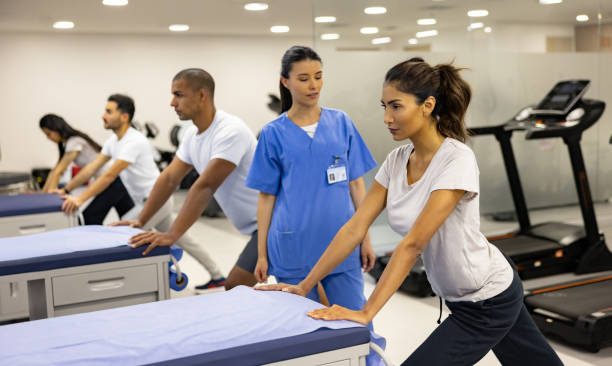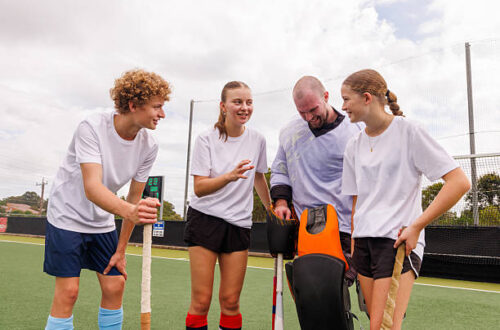Are you a student living with a constant ache in your neck or a persistent pain in your back? Do you spend hours hunched over a laptop, only to stand up feeling like a human question mark? You’re not alone. The student life of endless reading, writing, and screen time has a hidden cost: poor posture. This isn’t just about how you look; it’s about your well-being, your focus, and your academic performance.
While you might think of physical therapy as something for athletes with injuries, it’s actually one of the most powerful tools a student can use. It can help you fix the physical problems that come from hours of sitting, prevent future pain, and even improve your focus in class. By working with a physical therapist, you can learn how to stand tall, sit correctly, and feel better, not just for a day, but for a lifetime.
This complete guide will show you exactly how physical therapy can transform your health and your academic life. We’ll explore common issues students face. Then, we’ll look at how physical therapy can help. Finally, we’ll share simple routines you can start today.
The Silent Struggle: The Problems with Student Posture
Contents
The typical student lifestyle is a perfect recipe for posture problems. It’s a combination of prolonged sitting, sedentary habits, and bad ergonomic setups. Let’s break down the main issues that lead to pain and discomfort.
“Tech Neck” and the Strain on Your Spine
Think about how you hold your phone. You probably look down, right? That simple action puts a huge amount of pressure on your neck. For every inch your head tilts forward, the weight on your neck muscles and spine can increase by ten pounds. Over time, this constant strain leads to what’s known as “Tech Neck” – a condition that causes neck pain, headaches, and stiffness. It’s a modern epidemic among students and office workers alike.
The Slouch: Rounded Shoulders and a Weak Core
When you slouch over a desk, your shoulders naturally roll forward. This position causes the muscles in your chest to tighten and the muscles in your upper back to stretch and weaken. The result? Rounded shoulders that make it difficult to stand up straight. A weak core is a big part of this problem too. Without strong abdominal and back muscles to support your spine, your body naturally gives in to gravity and slumps. This can lead to nagging lower back pain, a common complaint for students everywhere.
Forward Head Posture: A Dangerous Habit
This is a specific form of poor posture that is especially common among students. When you lean forward to look at your screen, your head juts out in front of your body. This misalignment compresses the discs in your neck and can lead to pinched nerves, tingling in your hands, and chronic pain. Over time, it can even cause the upper part of your spine to curve in a way it shouldn’t. This forward head posture is a major contributor to the headaches and fatigue that so many students experience. It’s as if your head is constantly working against gravity, tiring out your entire body.
The “College Couch Potato” Effect
Many students get so caught up in studying that physical activity falls by the wayside. A lack of regular exercise can lead to muscle imbalances. Some muscles become tight (like your hip flexors from all that sitting), while others become weak. This imbalance throws your body out of alignment. It makes good posture harder to keep. Plus, it raises your risk of injury if you choose to be active.
The Posture Solution: How Physical Therapy Helps
A physical therapist works like a personal coach for your body. They don’t just treat the pain; they find the root cause of your problems and teach you how to fix them for good. Their approach is holistic, focusing on a combination of correction, strengthening, and education.
1. Posture Correction and Education
This is the most important first step. A physical therapist will start by assessing your posture and identifying your specific problem areas. They can see things you might not notice, like one shoulder being higher than the other or a slight curve in your spine. Based on this assessment, they’ll teach you the fundamentals of proper posture. This includes:
- How to Sit: Keeping your feet flat on the floor, your back straight against the chair, and your computer screen at eye level.
- How to Stand: Shoulders back, chest up, and core engaged.
- How to Walk: With a straight spine and a smooth, even gait.
They will also help you create an ergonomic study space. This means showing you how to set up your desk, chair, and computer to best support your body. Simple changes like using a lumbar support pillow or raising your computer screen can make a huge difference in preventing pain. A good physical therapist gives you specific tips. For example, place your monitor so the top is at eye level. Also, keep your elbows at a 90-degree angle to your desk.
2. Strengthening Weak Muscles
Physical therapy is all about building strength where you need it most. For students, this usually means focusing on the core, upper back, and shoulders. Building these muscles gives your spine a strong base. This helps you keep good posture throughout the day. A physical therapist might recommend a routine of exercises you can do at home with no special equipment.
- Planks: This is one of the best exercises for strengthening your entire core. It forces your abdominal and back muscles to work together to keep your body straight.
- Bird-Dog: This exercise improves your balance and strengthens your core and lower back at the same time. You start on your hands and knees and extend one arm and the opposite leg at the same time.
- A physical therapist may suggest exercises that mimic a “rowing” motion. This helps strengthen the muscles between your shoulder blades. This helps to pull your shoulders back and open up your chest, reversing the effects of slouching.
3. Increasing Flexibility and Myofascial Release
Tight muscles are a major reason for poor posture. A physical therapist will provide stretches to increase your flexibility and range of motion.
- Chest Stretches: A simple chest stretch against a doorway can help open up tight pectoral muscles. This is a great way to undo the hunched-over posture.
- Hip Flexor Stretches: Sitting for long stretches tightens your hip flexors. So, stretching is key to easing lower back pain. A simple kneeling lunge can do the trick.
A physical therapist might also show you myofascial release. This technique helps relieve tension in muscle tissue. While a therapist can do this manually, they can also teach you how to use simple tools at home, such as a foam roller or a tennis ball. Using a foam roller on your upper back or a tennis ball on a tight spot in your shoulder blade can help release knots and improve your posture.
4. The Mind-Body Connection
Physical therapy isn’t just about the body; it’s about the mind, too. Learning to listen to your body and recognize when it needs a break is a key skill. A physical therapist can teach you how to do a simple body scan to identify areas of tension. This mindfulness practice boosts your awareness of posture during the day. It helps you spot bad habits before they lead to pain.
Integrating Physical Therapy into a Student’s Routine
The most important part of physical therapy is consistency. A student can incorporate simple exercises and stretches into their daily routine. For example, they can do a few stretches during study breaks or at the end of the day. Consistent practice of these routines is what will lead to a lasting improvement in posture and a reduction in pain.
Here’s a sample routine you can try:
- Morning Reset: Start your day with 5 minutes of light stretching to warm up your muscles and set a good tone for the day.
- Study Break Stretches: Every 30-45 minutes, stand up and do a quick neck roll, spinal twist, and a chest stretch. This mini-break is a powerful way to refresh your body and mind.
- Evening Wind-Down: At the end of the day, do a longer stretching routine to release all the tension you’ve built up. Focus on your back, shoulders, and hips to prepare your body for a good night’s sleep.
Beyond Posture: The Fitness and Academic Benefits
The benefits of physical therapy for students go far beyond just fixing a slouch. A body free of pain and tension is a body ready for action.
Improved Concentration and Focus
It’s hard to focus on a lecture when your neck is aching. By fixing your posture, physical therapy removes a major distraction. When your body is comfortable and properly aligned, your mind is free to concentrate on what really matters: learning. This can lead to better grades and a deeper understanding of your subjects.
The Link Between Posture and Mood
This might surprise you, but your posture can directly affect your mood and confidence. Studies have shown that standing and sitting with good posture can lead to a more positive mood and a feeling of greater self-confidence. When you slouch, you can feel less powerful and more stressed. By correcting your posture, you can actually improve your mental state and feel more in control of your academic life.
Increased Energy Levels
When your muscles are tight and your posture is poor, your body has to work harder to do simple things, which can make you feel tired. By strengthening your core and improving your posture, you make your body more efficient. This means you’ll have more energy throughout the day, which can help you stay alert during class and study sessions.
Reduced Stress
Chronic pain can be a major source of stress. When your body is constantly in pain, your brain is on high alert. Physical therapy can help break this cycle. Exercises and stretches ease pain and release endorphins. Endorphins are the body’s natural stress relievers. This can lead to a more relaxed and positive mindset, which is crucial for handling the pressures of academic life.
Injury Prevention
For students who play sports or are active, good posture is key to preventing injuries. When your body is aligned, your muscles and joints face less stress. This lowers your chances of injury during physical activity.
FAQs about Physical Therapy for Students
Q1: Is physical therapy only for injuries?
A: No, absolutely not! While physical therapy is a go-to for recovering from injuries, it’s also a powerful tool for prevention. A physical therapist can help you identify and correct bad habits before they lead to serious pain or injury. Think of it as a proactive investment in your long-term health.
Q2: Will I have to spend a lot of time in physical therapy?
A: A typical plan for a student might involve a few sessions with a therapist to create a personalized routine. After that, the real work happens at home. The therapist gives you a set of exercises and stretches to do on your own. Consistency is more important than a lot of time in a clinic.
Q3: Is physical therapy expensive?
A: The cost depends on your insurance. Many student health plans cover physical therapy. It’s a good idea to check your coverage beforehand. Many clinics also offer flexible payment plans. In the long run, therapy often costs less than living with chronic pain. It can save you from lost productivity and long-term medical issues.
Q4: How do I find a good physical therapist?
A: You can ask a doctor for a referral, but many states allow you to go directly to a physical therapist without one. You can also search online for physical therapists in your area. Look for a professional with experience in posture correction or with student-athletes.
Q5: What’s the difference between a physical therapist and a chiropractor?
A: Physical therapists use a holistic approach. They focus on exercise, stretching, and strengthening to address the root cause of the problem. Chiropractors primarily use manual adjustments to the spine to relieve pain. Physical therapy has many benefits. It’s often the best choice for improving posture and building strength over the long term.
Q6: How often should I do my physical therapy exercises to see results?
A: A physical therapist will give you a specific plan, but a general rule of thumb is to do your exercises a few times a week, and your stretches daily. The key is to be consistent. Even doing a few minutes of stretches every day is more effective than doing a long session once a week.
Final Thoughts
The student life can be tough on your body, but it doesn’t have to be. By understanding the link between poor posture, pain, and academic performance, you can take a proactive step toward a healthier future. Physical therapy offers a clear path to correcting bad habits, building strength, and reducing pain. It’s an investment in your well-being that will not only help you succeed in your studies but also set you up for a lifetime of better health. So, don’t just push through the pain. Take control of your posture and feel the difference it makes in every part of your life.





